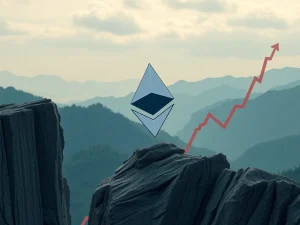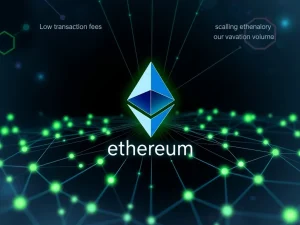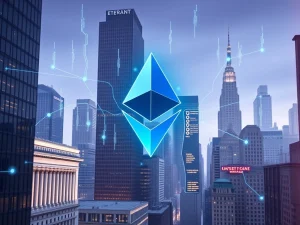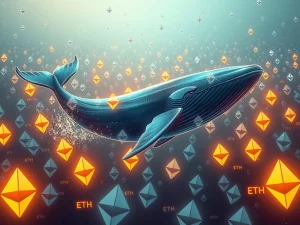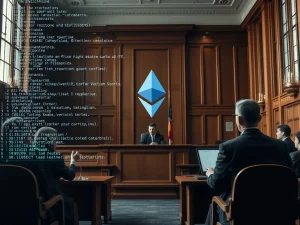Ethereum Staking: Vitalik Buterin Confronts Alarming Exit Queue FUD

The cryptocurrency world often experiences intense debates and speculation. Recently, a significant discussion unfolded around Ethereum staking mechanics. Ethereum co-founder Vitalik Buterin stepped forward, directly addressing mounting concerns. He specifically defended the network’s 45-day exit queue. This response came after weeks of what many termed ‘FUD’ – fear, uncertainty, and doubt – regarding the staking process. This article explores the controversy, Buterin’s defense, and the broader implications for the blockchain ecosystem.
Understanding the Ethereum Exit Queue Dynamics
The Ethereum exit queue has become a focal point of recent scrutiny. This queue manages validators wishing to withdraw their staked Ether (ETH) from the network. Currently, validators face a waiting period that has stretched to approximately 45 days. This duration sparked criticism from various industry figures. Galaxy Digital’s head of DeFi, Michael Marcantonio, publicly voiced his concerns on X. He labeled the lengthy queue as “troubling.” Marcantonio also drew a direct comparison to Solana, highlighting its significantly shorter two-day unstaking period. He later deleted these posts after considerable backlash.
The core function of the exit queue is to maintain network stability and security. It prevents a sudden, massive exodus of validators. Such an event could compromise the integrity of the Proof-of-Stake (PoS) consensus mechanism. The system incorporates a ‘churn limit,’ which restricts the number of validators that can exit or enter the network within a specific timeframe. This mechanism ensures orderly transitions. Therefore, while the wait can seem long, it is a deliberate design choice. It protects the network from potential attacks or rapid destabilization.
Validators play a crucial role in securing Ethereum. They propose and validate new blocks. They also ensure the accuracy of transactions. By staking their ETH, they commit to upholding the network’s rules. This commitment is essential for decentralized security. The exit queue is a component of this robust security framework. It balances validator flexibility with network resilience.
Vitalik Buterin’s Ideological Defense of Staking
Vitalik Buterin responded to the criticisms with a distinctly ideological perspective. He likened unstaking from Ethereum to a “soldier deciding to quit the army.” Buterin emphasized that staking involves “taking on a solemn duty to defend the chain.” This analogy highlights the deep commitment expected from validators. It frames their role as more than a simple investment. Consequently, Buterin argued that “friction in quitting is part of the deal.” He further explained, “An army cannot hold together if any percent of it can suddenly leave at any time.”
Buterin’s argument underscores Ethereum’s foundational philosophy. It prioritizes long-term security and decentralized governance. He acknowledged that the current staking queue design is not optimal. However, he cautioned against reducing constants. Such changes, he stated, would make the chain “much less trustworthy.” This would particularly impact nodes that do not come online frequently. His comments reinforce the idea that Ethereum’s design choices are intentional. They aim to create a highly secure and reliable global settlement layer. The trade-off for this security is sometimes convenience for individual stakers. Therefore, Buterin’s defense aligns with Ethereum’s core values.
The Genesis of Galaxy Digital FUD
The recent wave of Galaxy Digital FUD originated from specific market activities and statements. Michael Marcantonio’s now-deleted posts on X were a primary catalyst. He openly questioned Ethereum’s suitability for global capital markets. His critique focused solely on the exit queue duration. This stance drew immediate attention due to Galaxy Digital’s significant involvement in the crypto space. The firm has a notable history of investments and partnerships within the industry. This context lent weight to Marcantonio’s comments, despite their eventual retraction.
Significantly, Galaxy Digital recently made substantial moves into the Solana ecosystem. The firm purchased $1.5 billion worth of Solana (SOL) through a partnership. This collaboration involved Multicoin Capital and trading firm Jump Crypto. Furthermore, Galaxy Digital became the first Nasdaq-listed company to tokenize its shares on Solana. These strategic investments suggest a potential bias. Critics quickly pointed out the timing and nature of Marcantonio’s comments. They viewed them as an attempt to undermine Ethereum while promoting Solana. This perception fueled the community’s strong negative reaction. Consequently, the incident highlighted the competitive dynamics between major blockchain networks.
Solana Staking: A Different Unstaking Philosophy
In contrast to Ethereum, Solana staking offers a significantly faster unstaking process. Solana validators typically need only two days to withdraw their assets. This speed is a key differentiator for the network. It reflects Solana’s design philosophy, which emphasizes high throughput and rapid transaction finality. Solana aims to process thousands of transactions per second. Its unstaking mechanism aligns with this focus on efficiency and quick asset liquidity. Therefore, for users prioritizing rapid access to funds, Solana presents an attractive alternative.
However, this difference in unstaking times stems from fundamental architectural choices. Ethereum’s Proof-of-Stake model incorporates specific security measures. These measures include the churn limit and the lengthy exit queue. They are designed to protect against certain attack vectors. Solana, conversely, uses a different consensus mechanism. It combines Proof-of-Stake with Proof-of-History. This allows for faster block finalization. While efficient, critics argue that such speed might involve different trade-offs in terms of decentralization or security. Ultimately, both networks offer distinct value propositions. Their respective staking and unstaking mechanisms reflect these underlying design philosophies.
Community Pushback and Industry Implications
The strong criticisms from Galaxy Digital sparked a significant backlash from the Ethereum community. Many prominent figures quickly condemned Marcantonio’s remarks. Former Consensys product manager Jimmy Ragosa publicly called out Marcantonio and Galaxy Digital. He stated that the “relentless ETH FUD” had unintended consequences. According to Ragosa, many entities with vested interests in Ethereum were now reconsidering their business with Galaxy. This indicates a potential economic fallout for the firm. The community’s response was swift and decisive. It demonstrated the strong loyalty and interconnectedness within the Ethereum ecosystem.
Crypto lawyer Gabriel Shapiro also weighed in on the controversy. He commented on the deletion of Marcantonio’s posts. Shapiro described the original remarks as “insanely gaslighty psyops.” He ironically added that he wished the posts had remained visible. He believed they “only made Ethereum look great both technologically and culturally.” This sentiment highlights the community’s confidence in Ethereum’s fundamentals. Anthony Sassano, a well-known Ethereum educator, went further. He recommended that people “no longer do business with Galaxy.” Sassano asserted that deleting tweets does not change the fact. He believes Galaxy’s ‘Head of DeFi’ lacked a basic understanding of the industry. This incident clearly demonstrated the power of community sentiment in the decentralized space. It also showed the potential risks of perceived FUD from established financial institutions.
Ethereum’s Robust Network Security and Staking Health
Despite the recent FUD, the Ethereum network remains exceptionally secure and healthy. Over a million active validators currently secure the chain. They collectively stake a staggering 35.6 million ETH. This figure represents almost 30% of the entire Ethereum supply. Such a large number of validators and staked ETH provides immense security. It makes the network highly resistant to attacks. This extensive participation underscores the confidence the community places in Ethereum’s long-term viability. The high volume of staked assets creates a significant economic barrier for any malicious actors. Therefore, the network’s fundamental strength is undeniable.
The Ethereum exit queue, while lengthy, has shown signs of normalizing. It recently dipped over the past few days. However, it still holds approximately 2.5 million ETH awaiting withdrawal. A significant portion of this queue resulted from an exploit at Kiln Finance. This incident temporarily inflated the numbers. Conversely, the entry queue for new validators is also substantial. It currently stands at 512,000 ETH. This entry queue recently hit a two-year high. This surge indicates continued institutional accumulation and growing interest in Ethereum staking. Both the entry and exit queue dynamics reflect a vibrant and active staking ecosystem. They demonstrate ongoing engagement from both existing and new participants.
Balancing Trustworthiness and User Experience in Staking Design
The debate surrounding the Ethereum exit queue highlights a critical challenge. Blockchain networks must balance security and trustworthiness with user experience. On one hand, a robust exit queue ensures network stability. It protects against rapid changes in validator participation. This design choice contributes directly to the chain’s overall trustworthiness. It reassures users and developers that the network is resilient. On the other hand, a lengthy waiting period can deter potential stakers. It reduces liquidity and flexibility for participants. This can impact the user experience, especially for those accustomed to faster withdrawal times on other chains like Solana.
Achieving the optimal balance is complex. Vitalik Buterin himself acknowledged that the current design is not ideal. However, he firmly defended the underlying principles. He believes that compromising security for convenience would be a detrimental trade-off. The ongoing discussions will likely drive future innovations. Developers will explore ways to potentially improve queue efficiency. They must do so without sacrificing core security guarantees. This continuous evolution is vital for Ethereum’s long-term success. It ensures the network remains competitive and secure.
Looking Ahead: Potential Optimizations for the Ethereum Exit Queue
While Vitalik Buterin defended the current design, he also indicated room for improvement. The Ethereum community is constantly exploring potential optimizations for the exit queue. Any changes would require careful consideration. They must not compromise the network’s security or decentralization. One area of focus could be dynamic adjustments to the churn limit. This might allow for faster exits during periods of low network stress. Conversely, it could slow exits during high-stress periods. Such a dynamic system could offer more flexibility.
Furthermore, layer-2 solutions and liquid staking protocols continue to evolve. These innovations offer indirect ways to manage liquidity for stakers. Liquid staking tokens (LSTs) allow users to access their staked ETH value. They can use LSTs in DeFi protocols while their ETH remains locked. This provides a workaround for the illiquidity of the exit queue. As these solutions mature, they could significantly enhance the overall Ethereum staking experience. They offer greater financial flexibility. Ultimately, the future of the exit queue will involve a combination of protocol-level adjustments and ecosystem-level innovations. These efforts aim to enhance both security and user satisfaction.
Conclusion: Navigating FUD in the Crypto Landscape
The recent controversy surrounding Ethereum’s staking exit queue serves as a powerful reminder. The crypto landscape is constantly evolving. It is often subject to intense scrutiny and competitive narratives. Vitalik Buterin’s firm defense of Ethereum’s design principles was crucial. It provided clarity amidst the Galaxy Digital FUD. His explanation underscored the network’s commitment to security and trustworthiness. Despite the criticisms, the Ethereum ecosystem demonstrates remarkable resilience. It continues to attract significant participation. Both validator entry and exit queues remain active. This indicates a healthy and dynamic network.
Ultimately, the comparison between Ethereum and Solana staking highlights fundamental differences. Each blockchain prioritizes distinct aspects of network design. Ethereum opts for robust security and decentralization, even if it means longer unstaking times. Solana prioritizes speed and efficiency. Investors and users must understand these trade-offs. They need to choose networks that align with their priorities. As the industry matures, such debates are inevitable. They drive innovation and greater transparency. They also encourage a deeper understanding of blockchain technology. This ensures the continued growth and stability of the decentralized future.


